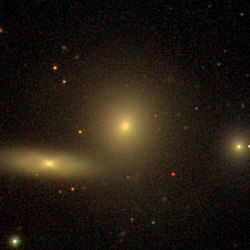NGC 3873 is an elliptical galaxy located about 300 million light-years away[2] in the constellation Leo.[3] The galaxy was discovered by astronomer Heinrich d'Arrest on May 8, 1864.[4][5] NGC 3873 is a member of the Leo Cluster.[6]
| NGC 3873 | |
|---|---|
 SDSS image of NGC 3873 (center), and NGC 3875 (lower left). | |
| Observation data (J2000 epoch) | |
| Constellation | Leo |
| Right ascension | 11h 45m 46.1s[1] |
| Declination | 19° 46′ 26″[1] |
| Redshift | 0.018126[1] |
| Heliocentric radial velocity | 5434 km/s[1] |
| Distance | 302 Mly (92.7 Mpc)[1] |
| Group or cluster | Leo Cluster |
| Apparent magnitude (V) | 13.85[1] |
| Characteristics | |
| Type | E[1] |
| Size | ~130,000 ly (40 kpc) (estimated)[1] |
| Apparent size (V) | 1.5 x 1.3[1] |
| Other designations | |
| CGCG 97-137, KCPG 300A, MCG 3-30-106, PGC 36670, UGC 6735[1] | |
On May 15, 2007 a type Ia supernova designated as SN 2007ci was discovered in NGC 3873.[7][8][9]
See also
editReferences
edit- ^ a b c d e f g h i j "NASA/IPAC Extragalactic Database". Results for NGC 3873. Retrieved 2018-07-31.
- ^ "Your NED Search Results". ned.ipac.caltech.edu. Retrieved 2018-07-31.
- ^ "Revised NGC Data for NGC 3873". spider.seds.org. Retrieved 2018-07-31.
- ^ Steinicke, Wolfgang (2010-08-19). Observing and Cataloguing Nebulae and Star Clusters: From Herschel to Dreyer's New General Catalogue. Cambridge University Press. ISBN 978-1-139-49010-8.
- ^ "New General Catalog Objects: NGC 3850 - 3899". cseligman.com. Retrieved 2018-07-17.
- ^ "Detailed Object Classifications". ned.ipac.caltech.edu. Retrieved 2018-07-31.
- ^ "Bright Supernovae - 2007". www.rochesterastronomy.org. Retrieved 2018-07-31.
- ^ "SN 2007ci | Transient Name Server". wis-tns.weizmann.ac.il. Retrieved 2018-07-31.
- ^ "2007ci - The Open Supernova Catalog". sne.space. Archived from the original on 2018-08-01. Retrieved 2018-07-31.
External links
edit- Media related to NGC 3873 at Wikimedia Commons
- NGC 3873 on WikiSky: DSS2, SDSS, GALEX, IRAS, Hydrogen α, X-Ray, Astrophoto, Sky Map, Articles and images